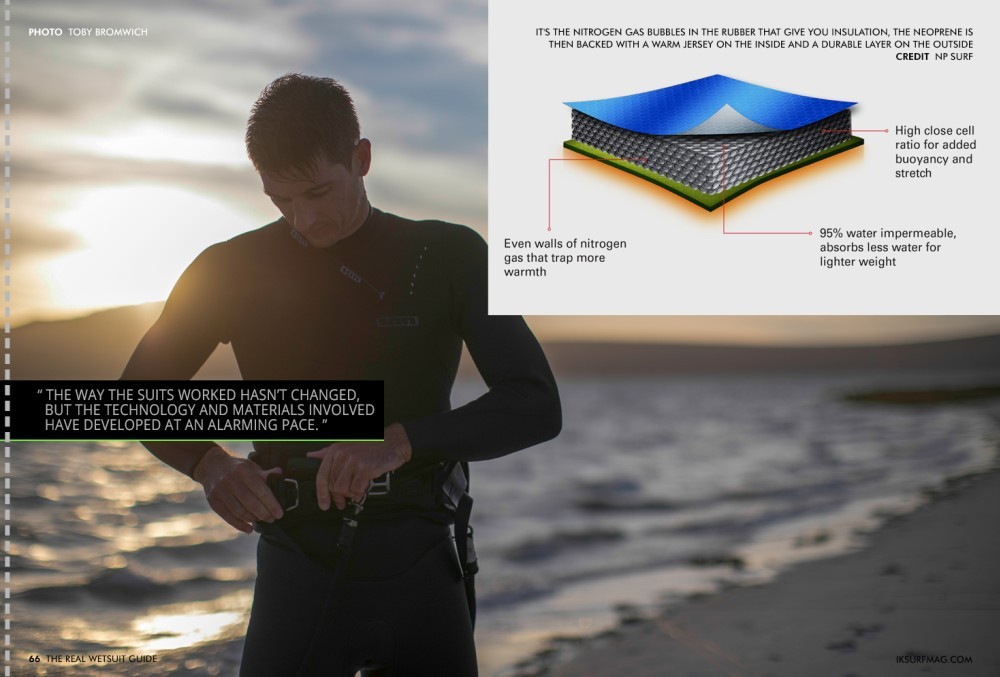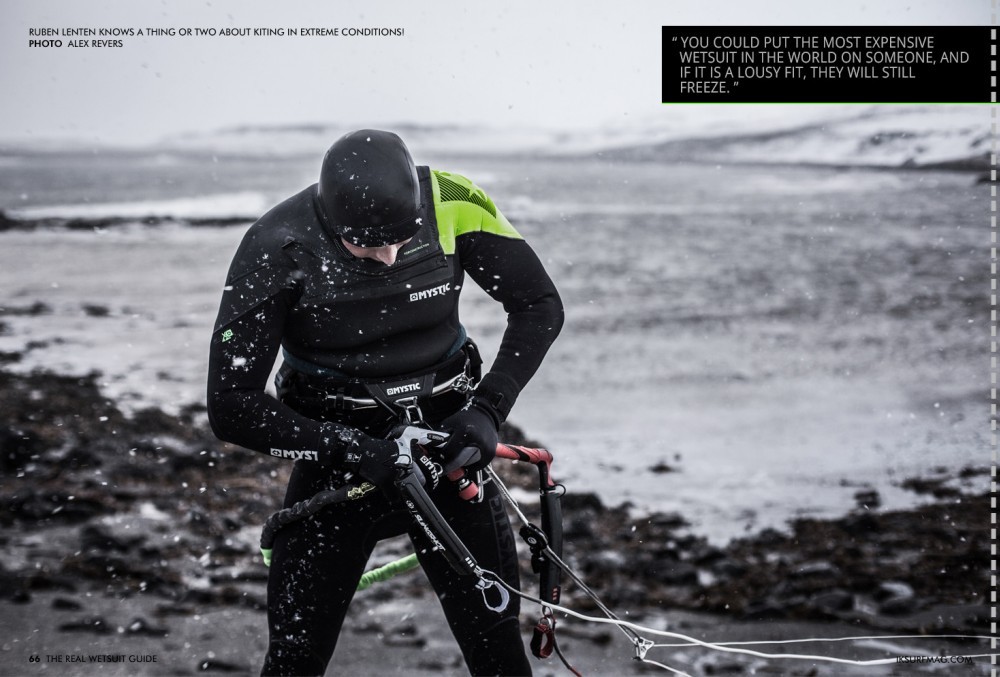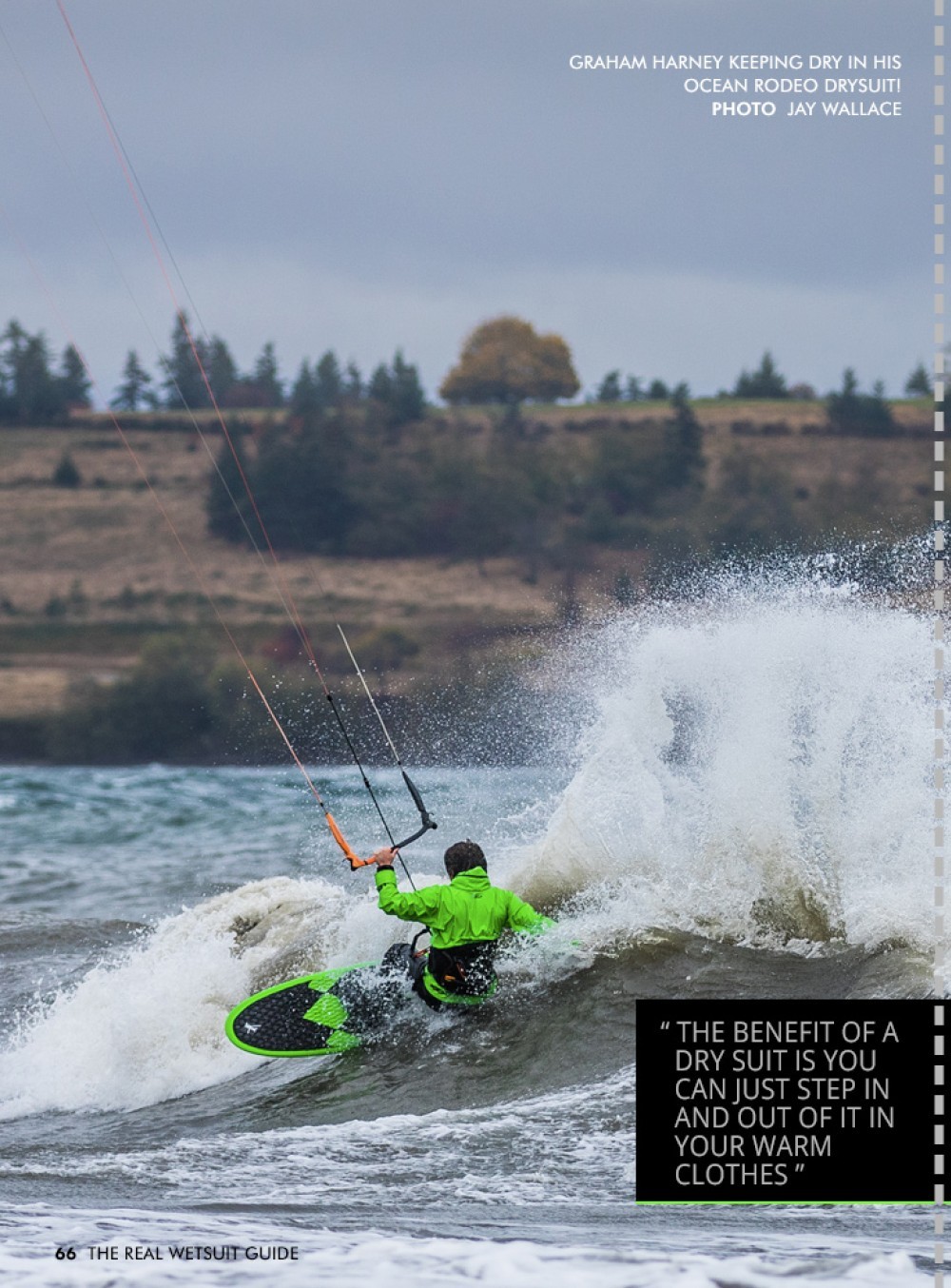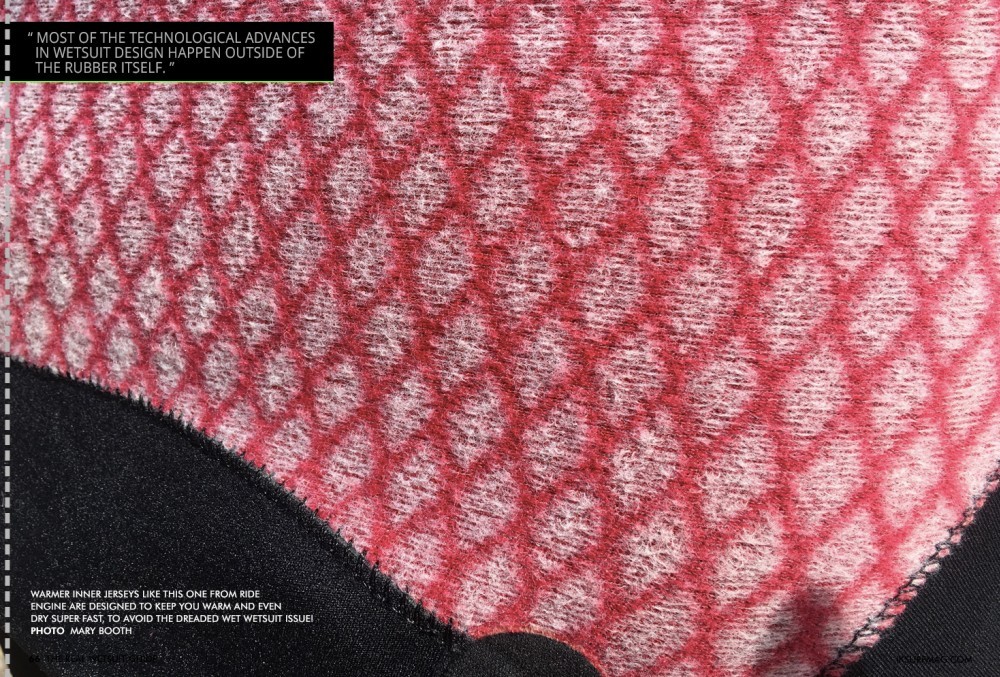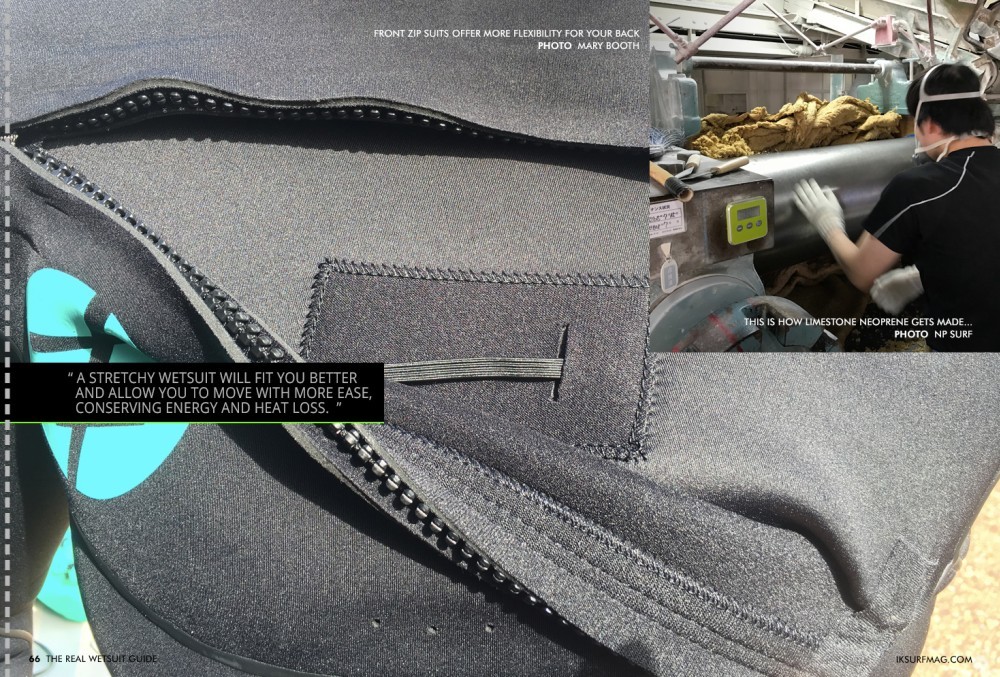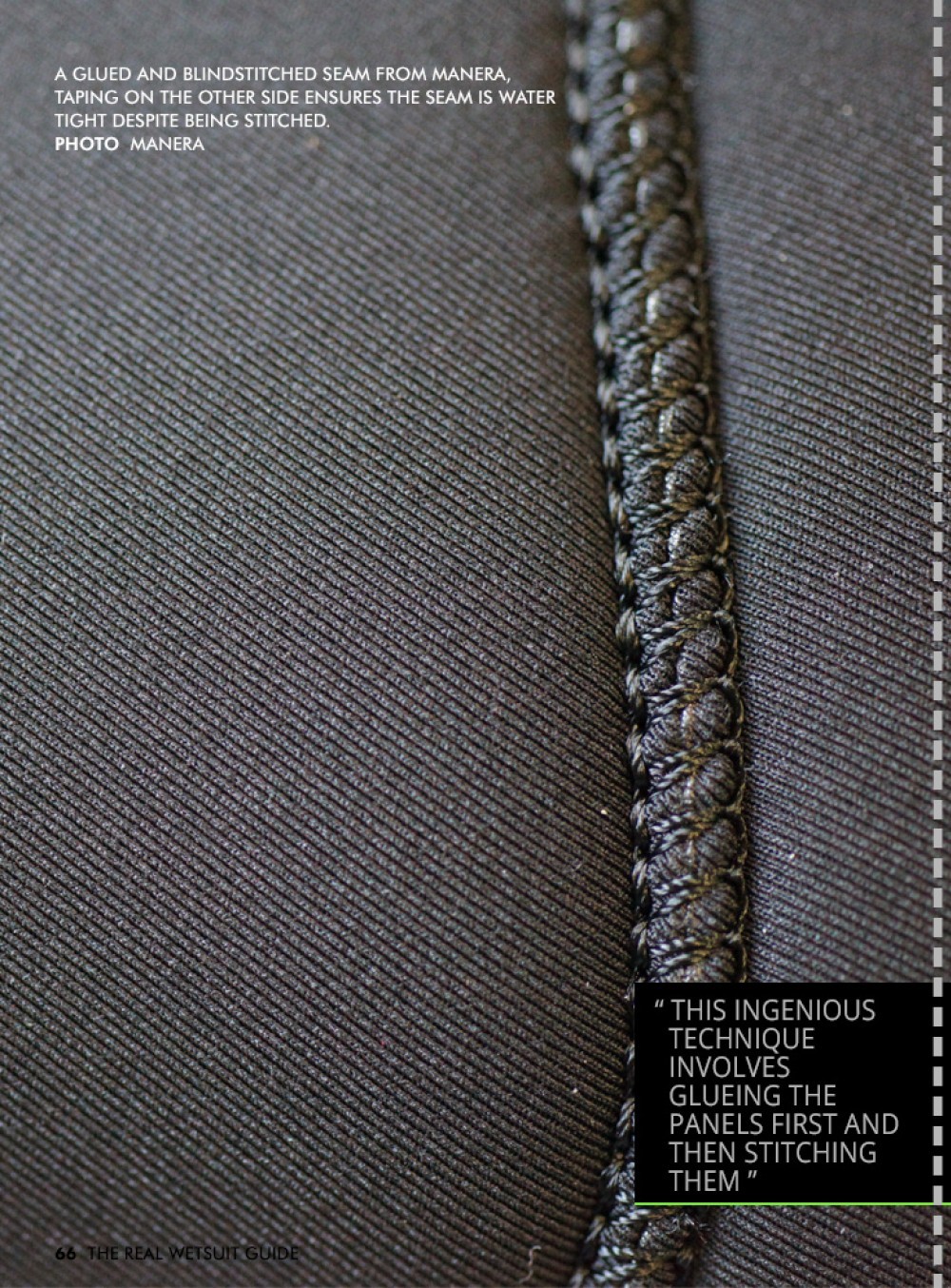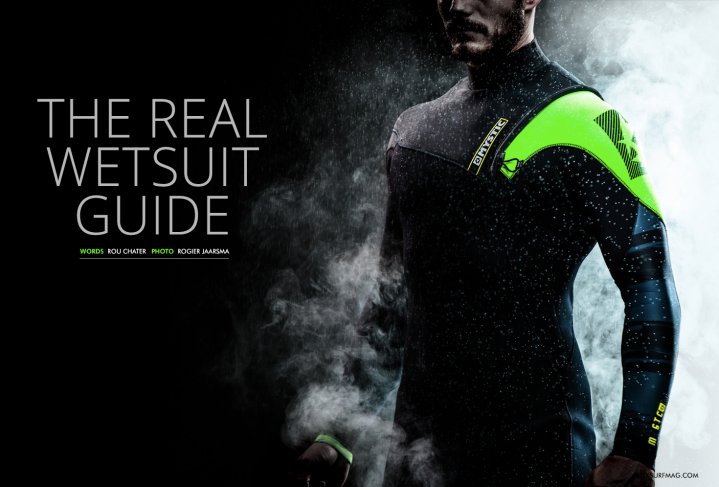
The Real Wetsuit Buyers Guide
Issue 66 / Tue 12th Dec, 2017
Looking to buy a new suit for the winter, look no further, this isn’t your average mags excuse for a guide which involves selling some wetsuit slots to brands, but an actual in depth look at neoprene and how it works to keep you warm!
All too often magazines will try and drum up some cash with a wetsuit guide; it’s an easy way to fill pages and make some money, each slot for each brand comes with a price. It’s also easy to do, just copy and paste some images and text from the manufacturer's website and hey presto.
Of course, we believe you are better than that and a “buyers guide” should look at the more important aspects of buying an expensive piece of rubber. Things like the fit, materials, the eco-footprint and ultimately the most crucial question of all, can you piss in it? A guide to buying a wetsuit if you will, as the name suggests.
If you don’t learn something new about neoprene after reading this, then you’re doing it all wrong!
What is a wetsuit?
Fortunately for us, the clue is in the name, it’s a suit that is designed to keep you wet. At least that is what it was initially designed to do, these days most modern winter suits do a pretty good job at keeping water out. The basic principles of a wetsuit haven’t changed since the first wetsuit was created.
Contrary to popular belief the wetsuit wasn’t invented by Jack O’Neill, that accolade goes to Hugh Bradner who is credited with being the “father of the modern wetsuit”. Hugh was the first person to realise an insulating layer of material consisting of trapped bubbles would significantly reduce the effects of heat loss on the human body when in the water.
He sent a letter detailing his idea to a few potentially interested parties, the US Navy being one of them. Willard Bascom, an engineer at the Scripps Institute of Oceanography, suggested to Bradner that neoprene could be an excellent material to use, however between the two of them they never got the idea to catch on or take off.
It was in 1952 that Jack O’Neill started using neoprene to make insulating vests for the surfers of California. The O’Neill Company was the first wetsuit manufacturer to make a commercial success of the concept, the frigid waters of California and the abundance of local surfers creating the perfect storm for a breakaway product.
After that, the humble wetsuit took off, as the popularity of surfing grew and the sport spread around the world the demand grew and grew, and more and more companies came to the fore. The science behind the way the suits worked hasn’t changed, but the technology and materials involved have developed at an alarming pace.
How Does A Wetsuit Work
Water conducts heat away from the human body 20-25 times faster than air, in layman’s terms as soon as you are submerged in water, you lose body heat at an alarmingly faster rate than if you were to be stood on the beach. A wetsuit is made of a closed cell foam called neoprene, which is a synthetic rubber, the neoprene consists of tiny bubbles of nitrogen gas.
The clever bit is that nitrogen, like most gases, has a very low thermal conductivity. This means that when it is placed next to your skin in the form of a wetsuit, your body heat gets pushed back into your body rather than escaping through the neoprene layer, keeping you warm.
As the name suggests though you are wet, so the suit is designed to trap a thin layer of water against the skin, this layer can then be heated by your body temperature, and even though you are wet, the insulating properties of the nitrogen bubbles in the neoprene will keep you warm. A common misconception is that it is the water that will keep you warm, this isn’t the case, the wetsuit works whether you are wet or dry as an insulating layer.
The real key to a wetsuit though is the ability to either keep that thin layer of water in or even limit the amount of water that enters, as is the case with modern winter “semi-dry” suits. If a wetsuit fits poorly, especially around the wrist, ankle and neck seals, water is free to flush in and out, each time water enters and leaves the suit it takes body heat with it, making you cold.
If the wetsuit is too loose or baggy, then pockets of water can form and again the water will drain your body heat at an alarming rate. Therefore, the crucial factor in any suit, regardless of brand name or price, is the fit. You could put the most expensive wetsuit in the world on someone, and if it is a lousy fit, they will still freeze.
Wetsuit, semi-dry or drysuit?
Once again the clue is in the name here, the humble wetsuit works as we have already explained. A modern semi-dry suit aims to limit the amount of water entering the suit, water will always get in, but your body should be able to heat it, and the suit should be able to retain the small amount of water, especially if it fits properly. Pretty much every modern winter suit on the market today is designed to be semi-dry and will often be referred to as a wetsuit rather than a semi-dry.
A dry suit, however, is as the name suggests, dry; they offer no insulation so won’t keep you warm (although there are now some drysuits made of neoprene with all the thermal advantages it provides); the idea is to wear warm clothing underneath. The benefit of a dry suit is you can just step in and out of it in your warm clothes in the car park. Some of them also offer superior wind chill capabilities as the outside of the material doesn’t absorb water. However, they can be bulky for kiters, especially when performing tricks and body dragging.
They do also usually let water in during heavy wipeouts too, as such they are perfect for the freeride cruiser in very low temperatures, but not so much for the aggressive freestyler who is slamming hard all the time. They can also be expensive, and you can’t piss in them to warm up either. We’ll look at them in more detail in another article, for now, let’s get back to wetsuits.
More Than Just Rubber?
Neoprene is an essential element of any wetsuit; it is the insulator that makes it work after all. However, in its raw form, it is just that, rubber filled with tiny nitrogen air bubbles. It needs to be lined to make it comfortable against your skin. It needs to be stitched together to create the shape you need; it needs to stretch with the movements of your body. Ultimately it needs to seal in, and out water as much as possible, no mean feat when you consider the number of stitches required to make a suit!
Most of the technological advances in wetsuit design happen outside of the rubber itself. The linings and backings, the stitching, taping and sealing of the seams and the coatings applied to repel water and keep the suit in good shape. In terms of design, the goal is to maximise the fit and feel of the suit around your body, the less it interferes with the way you ride, the better.
When you look at a high-end suit in the shop and wonder if the price tag is justified compared to a cheaper suit, it is these external factors that will make up the extra cost to you. A lower cost suit may well use the same rubber, but the seams won’t necessarily be sealed, the inner jersey probably won’t be as warm and will take longer to dry and crucially it is unlikely to stretch as much as an expensive suit.
The Importance Streeeeeeeeetch
Years ago I came back from a season teaching windsurfing in Turkey, took a train from Ramsgate to Hayle in Cornwall with all my windsurfing gear and entered the British National Wavesailing Championships. I’d borrowed my Dad’s old ‘Gul Steamer’ wetsuit to keep me warm, after all, I’d spent the last couple of years wearing nothing but board shorts.
Despite a lack of wind my heat came around, and I donned the rubber, bear in mind this was some 20 years ago. Let’s just say my Dad’s ancient steamer wasn’t cutting the mustard; I could barely bend my arms, let alone walk. Sure I was encased in a thick layer of warm rubber, but what’s the point of being warm if you can’t move?
Neoprene in itself is very stretchy, but the backing it is bonded too, the layers you see and feel on either side of the rubber never used to have much give. As fabrics improved the nylon backings were replaced with materials such as Lycra. The properties of these materials allowed the suits to stretch, even more, suddenly wetsuits got exciting.
You could pull the arms out to twice their length, a great sales technique used in the shops. A stretchy wetsuit will fit you better and allow you to move with more ease, conserving energy and heat loss. The thicker the suit is, the more seams, zips and thermal linings it has, the less it will stretch, so by the time winter rolls around you are looking for a compromise of warmth and flexibility.
How Thick Is Too Thick?
Ideally, you want to wear the thinnest wetsuit you can get away with so it won’t impact on your performance on the water. Suits are measured in millimetres according to their thickness. Usually, the first number relates to the main body of the suit, while the second number will refer to the legs and arms. A 6/5, for instance, will have 6mm of neoprene on the body and 5mm on the rest of the suit.
The thicker layer keeps you warm while using thinner material elsewhere still allows freedom of movement. A common ‘trick’ among wetsuit brands is to use expensive and stretchy neoprene in the arms of the suit. This means when a customer walks along the rail in the store they will invariably stretch the arms to see how much stretch the suit has. When you are shopping for a suit, go a step further, stretch the legs and also put the suit on and see how manoeuvrable it is.
In recent years a lot of advancements have been made with the thermal linings of the suit. Woolly jerseys on the inside trap air and water and retain a lot of heat, some of them are even quick draining to allow them to dry fast. These technologies allow you to wear thinner suits than previously, there are some 4mm suits on the market that can keep you as warm as a 5mm or 6mm for instance while offering a better range of movement.
Ultimately the conditions you ride in will determine the thickness of the suit you buy. If you live in the polar regions of Europe you’ll be valuing warmth above all else, in the more temperate zones during the winter then flex may well override out and out warmth as the temperature never gets too cold. Ultimately choose the best suit that is suited, pun intended, to your conditions.
What’s in a seam?
Due to the shape of the neoprene material, think thin and flat, panels need to be cut and stitched together to create a three-dimensional suit from the flat material. This means you need to stitch and bind the panels together. Neoprene itself is watertight, but if you imagine the number of stitches you need to build a suit and the holes that creates, suddenly it isn’t so watertight after all.
The ‘glued and blindstitched’ revolution was arguably one of the biggest developments in wetsuit design since their inception. Almost all modern suits are glued and blindstitched as a minimum. This ingenious technique involves glueing the panels first and then stitching them with a hooked needle. The needle only penetrates halfway into the neoprene and doesn’t go all the way through, so instead of trying to plug thousands of tiny holes along the seams of the suit, you don’t have any.
In more recent years we have seen further developments with taping on the seams and ‘fluid seam welds’ or ‘liquid seams’ as they are sometimes called. Advancements in glues means that suits can either have special water-resistant taping applied to the seams after they have been stitched or have a liquid layer of rubber applied over the top to ensure no water can penetrate the seam.
However, your seams are built it is important to ensure they can stretch. Having the most flexible wetsuit in the world won’t be any good if the seams offer no movement or stretch at all as they will make the whole suit rigid.
Coated in Magic?
Arguably the last area to consider is the coating applied to the outer layer of material on the suit. UV coatings can be common, but for a winter suit, a water-repellent coating is often applied. The biggest issue with a wetsuit, especially for the kitesurfer is wind chill. Usually, we go to the beach because it is windy, so wind chill becomes a real issue.
At 10 degrees with a wind speed of 25mph, the wind chill factor will bring the temperature down to 6 degrees. At 5 degrees on a 40mph day, the wind chill will drop the temperature to -2! That’s pretty astounding when you think about it and a factor to consider. It’s something wetsuit companies think about too, especially the kitesurfing focused brands.
As neoprene is a smooth, non-absorbent rubber, water cannot sit on it or penetrate it either. The most straightforward option in the battle of wind chill then is to use a single lined neoprene, in other words, you add a backing layer to the inside of the suit, but leave the outside of the suit naked. This single lined neoprene offers unrivalled wind chill resistance. However, the downside is the neoprene itself is very fragile and susceptible to nicks and cuts from sharp objects. Think of your kitesurfing fins, the stones on the beach and you get the picture. It’s very easy to put a hole in a single lined suit.
To combat this, manufacturers will often have single lined panels, usually, on the back and chest of the suit, these will help retain warmth while the more stressed areas such as the bum and legs of the suit get the protection of a double lined neoprene which is far more durable.
Another approach is to use a fully double lined neoprene across the whole of the suit and coat it with a water repellent so it won’t absorb water and won’t succumb to the effects of wind chill. In recent years these coatings have got better, although the author has never worn a suit where they have been 100% effective. After a few wipeouts and dunkings, the outer layer soon becomes wet and wind chill sets in. Of course, with a decent suit, this shouldn’t be too bad as remember it is the neoprene itself, which provides the insulation.
Back Zip, Full Zip or No Zip?
The zip on a suit is an obvious entry point for water, in recent years we’ve seen barriers put in place to prevent the water from directly touching your skin and zipper technology has improved too. One thing you can’t do with a zip is stretch it. It’s a real issue when it comes to manoeuvrability. The traditional back zip offers the easiest point of entry, but also puts a very inflexible area right in the middle of a part of the suit that should flex.
Chest or front zips allow the whole back of the suit to stretch but can make entry difficult for some people. Personally, I love front zip suits, but my brother Alex hates them, if you can get on with the trickier entry into the suit then the front zip is superior in my eyes, and this is reflected in the price tag, front zips are usually found on high-end suits. However, it is an area of personal preference.
In the future, and indeed already, we see 'no zip' or 'zipperless' suits. By removing the zip entirely, you remove the most inflexible part of the suit. However, entry into the suit can be trickier and sometimes they aren’t as good at keeping water out. Advances in design, technology and materials are changing this though, and zipperless suits look set to gain some market traction in the years to come. They certainly offer superior comfort once you are inside them!
If you’ve managed to make it this far then, you’ve probably learned a fair amount about what makes a wetsuit work and hopefully have a better understanding of the kind of suit you need. In order to create this article, we spoke to some of the leading people behind some of the biggest brands in the industry.
We’ve published the full interviews with these industry leaders on the website. So if you want to get even more information on a brand-specific level then click HERE. In speaking to these designers and brand managers we learned one thing, they all value fit and flexibility as two of the most essential factors in wetsuit design.
They also all have their own kite specific technologies, which are important for kiters to consider. A surf brand will design a suit with surfing in mind. A surfer spends most of his time sitting submerged in the water preferably on a glassy day. We, on the other hand, spend nearly all our time standing, blasting along the surface of the water and on occasion crashing into it with considerable force. Our needs are totally different to that of a surfer, and that is why I would encourage you to look towards the kite focused suits when it comes to making a purchase.
It will make a huge difference to the way your suit performs and handles the rigours of our sport. If you’ve ever suffered from “elephant legs” it’s because you haven’t got a kite focused suit. Get one, and this becomes a thing of the past there are various designs among the brands, but they all work, and they all prevent elephantitis legus!
We asked them about the wetsuits of the future, and the theme here seems to be moving towards a zipperless trend. The zip is the least flexible part of the suit, so removing it makes sense when you consider the importance of flex. Some brands are already offering zipperless suits, and this is an area where they all seem to be headed.
Eco Warriors?
We also asked them about wetsuit manufacture and the impact it has on the planet. Sadly our sport isn’t exactly eco-friendly, the manufacturing process for kites, boards and accessories is by its very nature is not exactly green. Most wetsuits brands are now using Limestone Neoprene, rather than oil-based products. Sadly Limestone Neoprene still has an impact on the environment; however, it is considered to be a lot less than that of oil-based rubber.
Limestone Neoprene is also warmer as it has more air bubbles inside, around 30% more to be precise. This means you can use a thinner suit and get similar warmth, so less material is needed to create the suit in the first place. One interesting aspect of the eco-friendliness of a suit that came up in our discussions with the people behind the brands was the durability of the suit.
The longer the suit can last, the longer it will stay out of landfill. Also the more seasons you wear your suit for, the fewer suits you buy in a lifetime. Having a durable suit that lasts longer is, therefore, one of the best ways you can help the environment while still keeping warm. It’s an interesting take for sure, and as we progress from the throwaway society of old, spending a little more on a higher quality suit in the first place may well mean you can reduce your eco-footprint.
Another area the brands are investigating and utilising is with more eco-friendly glues and inks when it comes to dying the fabric coatings and putting the suit together. Consideration has also been made towards the water repellents used on the outside of the suits too. Anything that can be kinder to the environment is being looked at and utilised where possible.
However, everyone we spoke to was keen to point out that the importance of performance. This plays a huge roll when considering what measures they can take to improve the effect of the suit on the environment. Wetsuit technology has come so far, and it would seem somewhat foolish to make a badly fitting un-flexible suit that doesn’t keep you warm just because it saves the environment. What was great to see was that every brand we spoke to is becoming more and more aware and conscious of the need to consider the ecological impact of wetsuit manufacture.
The final questions we asked was arguably the best, can you piss in your wetsuit?
Here are the answers in full, so that we can set the record straight once and for all!
Julien Salles – Manera: “Ahahah I have no idea! Maybe we need to analyse my suit and see! ☺”
Bastian Harberler – ION Products: “We do not recommend to do so, but sometimes, there is just no other way, right? ☺”
Ediwn Honsbeek – Prolimit: “Most people do piss in their wetsuit. It is possible but you have to rinse it with fresh water or wash it with wetsuit shampoo.
It can be bad for the glue and lining on inside as acids from you pee can have a negative influence on the glue.”
Alex Bloenchinger – Ride Engine: “No comment!”
Christian Torrens – NP: “I would not be qualified to give you a scientific answer on that. But I guess it depends on the PH acidity level of your pee! ☺”
Max Blom – Mystic: “Yes you can, you won’t damage it. We won’t recommend peeing in a suit though, check out this definitive article on the subject right HERE.”
We’d like to thank everyone who took part in this article, for more details on each of the brands be sure to check out the individual interviews on the website which can be found HERE. Thanks to Edwin, Julien, Bastian, Alex, Christian and Max for helping us to put this together.
Videos
By Rou Chater
Rou has been kiting since the sports inception and has been working as an editor and tester for magazines since 2004. He started IKSURFMAG with his brother in 2006 and has tested hundreds of different kites and travelled all over the world to kitesurf. He's a walking encyclopedia of all things kite and is just as passionate about the sport today as he was when he first started!





